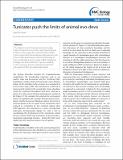Files in this item
Tunicates push the limits of animal evo-devo
Item metadata
| dc.contributor.author | Ferrier, David Ellard Keith | |
| dc.date.accessioned | 2012-11-16T15:31:01Z | |
| dc.date.available | 2012-11-16T15:31:01Z | |
| dc.date.issued | 2011-01-20 | |
| dc.identifier | 5347147 | |
| dc.identifier | fc4414a0-09fd-4a1b-a4cb-9eccda5fae6f | |
| dc.identifier | 78751573940 | |
| dc.identifier.citation | Ferrier , D E K 2011 , ' Tunicates push the limits of animal evo-devo ' , BMC Biology , vol. 9 , 3 . https://doi.org/10.1186/1741-7007-9-3 | en |
| dc.identifier.issn | 1741-7007 | |
| dc.identifier.other | ORCID: /0000-0003-3247-6233/work/36423831 | |
| dc.identifier.uri | https://hdl.handle.net/10023/3250 | |
| dc.description.abstract | The phylum to which humans belong, Chordata, takes its name from one of the major shared derived features of the group, the notochord. All chordates have a notochord, at least during embryogenesis, and there is little doubt about notochord homology at the morphological level. A study in BMC Evolutionary Biology now shows that there is greater variability in the molecular genetics underlying notochord development than previously appreciated. | |
| dc.format.extent | 606253 | |
| dc.language.iso | eng | |
| dc.relation.ispartof | BMC Biology | en |
| dc.rights | © 2011 Ferrier; licensee BioMed Central Ltd. This is an Open Access article distributed under the terms of the Creative Commons Attribution License (http://creativecommons.org/licenses/by/2.0), which permits unrestricted use, distribution, and reproduction in any medium, provided the original work is properly cited. | en |
| dc.subject | QH301 Biology | en |
| dc.subject.lcc | QH301 | en |
| dc.title | Tunicates push the limits of animal evo-devo | en |
| dc.type | Journal item | en |
| dc.contributor.institution | University of St Andrews.School of Biology | en |
| dc.contributor.institution | University of St Andrews.Scottish Oceans Institute | en |
| dc.contributor.institution | University of St Andrews.Marine Alliance for Science & Technology Scotland | en |
| dc.identifier.doi | 10.1186/1741-7007-9-3 | |
| dc.description.status | Peer reviewed | en |
This item appears in the following Collection(s)
Items in the St Andrews Research Repository are protected by copyright, with all rights reserved, unless otherwise indicated.

